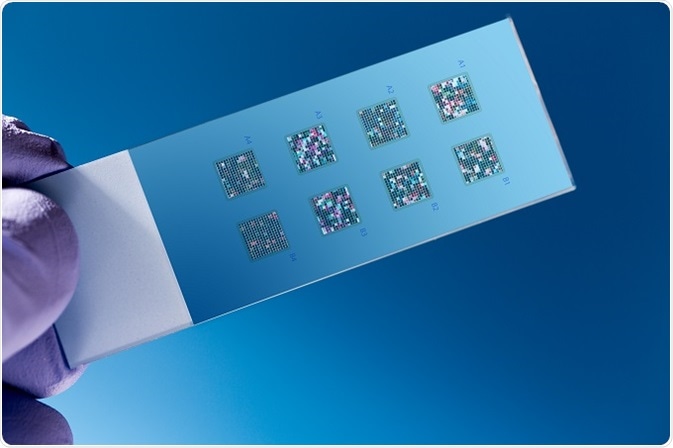
Protein and Peptide Microarray
Protein and peptide microarrays, the emerging tools for proteomics and clinical assays, are high-throughput methods that track binding events and activities, and decide the function of proteins on a large scale. Microarrays find their place in epitope mapping and serodiagnostic applications.

© science photo/Shutterstock.com
Protein microarray
Protein microarrays are classified as 1) analytical protein microarrays 2) functional proteins, and 3) reverse-phase protein microarrays, based on their application.
Analytical protein microarray
Antibody array is the most representative model of analytical protein microarrays. Using direct protein labeling, proteins are found after antibody capture. The sandwich assay format employs two different antibodies to find the targeted protein, allowing differentiation between two similar blood samples, for example.
Functional protein microarray
This type of array is created by use of proteins that are purified individually. The main function of this kind of array is to study the different biochemical properties of proteins. This may include the study of binding activities of protein as well as enzyme–substrate relationships. After the first effort that used protein kinases in yeast to determine the substrate specificity, many significant biological discoveries have since happened.
Reverse-phase protein array (RPPA)
RPPA is a type of microarray that allows testing of different probes of lysate samples that help in identifying specifically, the various proteins in it. Initially, these kinds of microarrays were used in monitoring prostate cancer patients to identify historical changes.
Applications
Various types of protein binding properties are detected by developing new assays to characterize protein-DNA and for protein–peptide interaction. Test ligands are directly or indirectly labeled with fluorescent dyes during the analysis of protein–protein and protein–lipid interactions.
Protein–small molecule interaction is used to discover new drug molecules and drug targets, while protein–glycan interaction finds the new role of protein glycosylation in mitochondrial protein function and localization. Since antibodies are widely used in proteomic studies, protein microarrays are helpful in profiling the monoclonal antibody specificity.
An important mechanism to directly control protein activity is the protein posttranslational modification (PTM). Protein application to phosphorylation finds the substrate specificity of the yeast kinome and discovers new tyrosine phosphorylation activity; ubiquitylation controls almost all sorts of cellular events in eukaryotes. Protein acetylation—histone acetylation and deacetylation promise to be important regulators of chromatin structure and transcription, while S-nitrosylation has effects on an extensive range of proteins involved in several cellular processes.
Protein microarrays are very useful in clinical research as they aid in developing highly sensitive and specific diagnostic and testing tools. Studies have found positive results for broad-spectrum antiviral development. Protein microarrays help to find a powerful biomarker to expedite detection or diagnosis of autoimmune diseases for severe acute respiratory syndrome (SARS), inflammatory bowel diseases (IBDs), and profile serological responses following bacterial and viral infection.
Library construction and microarray fabrication are two important factors to be considered for the success of microarray-based screening.
Peptide microarray
The well established “solid phase peptide synthesis” (SPPS), along with the comparatively easier fabrication of the corresponding microarrays, characterize peptide libraries as a very significant source of microarray applications. The idea of split-and-pool synthesis allowed creating large peptide libraries that consist of a huge number of molecules in very few short steps. A classic representative of peptide microarrays are kinase assays.
Knowledge-based peptide libraries
Knowledge-based libraries can be defined as libraries that are constructed using already known peptide sequences. These peptide libraries are mostly used in investigating proteins with known substrate or interacting partners. They can be constructed by using common combinatorial concepts such as positional scanning, alanine scanning, and amino acid deletion.
To discover peptide substrates with improved binding activity, positional-scanning libraries are used. They are constructed by the introduction of mutation within the known binding sites of the target protein at definite positions.
This can be used in alanine-scanning libraries in which the alanine residue replaces every amino acid in the peptide. It probes the contribution of each amino acid. Deletion libraries are designed by the systematic removal of flanking residues from the parent peptide. These libraries are used in determining the minimum sequence of a peptide needed for their normal activities to take place as usual. The routine investigation of amino acid residues that are essential for molecular interactions is done by the peptide arrays made of this kind of libraries.
Combinatorial libraries
When the target protein’s substrate is unknown, combinatorial peptide library-based microarrays are suitable. To reduce the synthesis of a large number of peptides, a semi-random combinatorial approach is used. This also helps in finding new peptide substrates and learning about proteins that are not known. Peptide microarrays are effective in categorizing known and unknown interactions between protein and peptide and offer possible tools to create peptide-based probes for functional annotation of RNAs in cells. Epigenetic modifications may have greater control on various human diseases.
Outlook
The high cost of instruments and library resources make it difficult for researchers to gain benefits from microarrays. However, peptide microarrays are much more consistent and less costly than protein microarrays. The different forms of microarray technologies, such as protein microarray and peptide microarray are analytical tools for proteomics research that facilitate drug discovery and have diagnostic applications.
Reviewed by Afsaneh Khetrapal BSc (Hons)
Sources:
Further Reading
Last Updated: Nov 29, 2017





















.png)












No hay comentarios:
Publicar un comentario